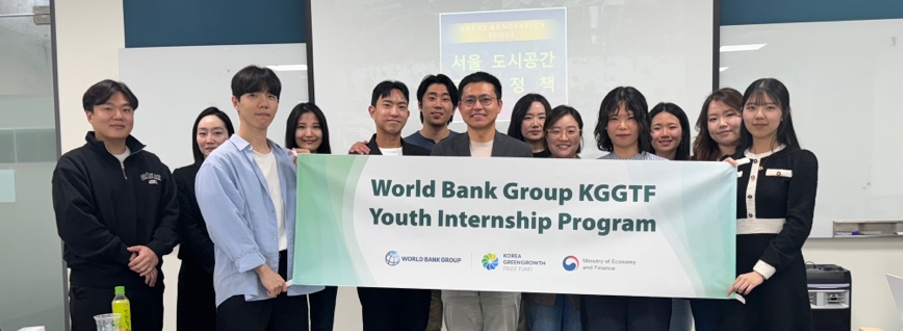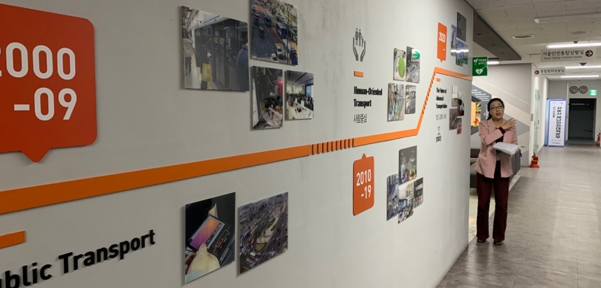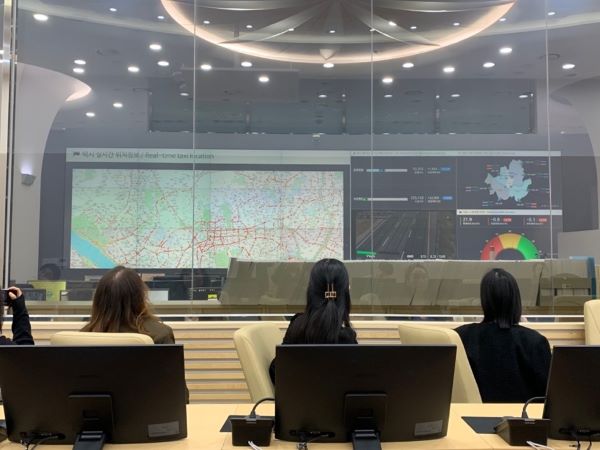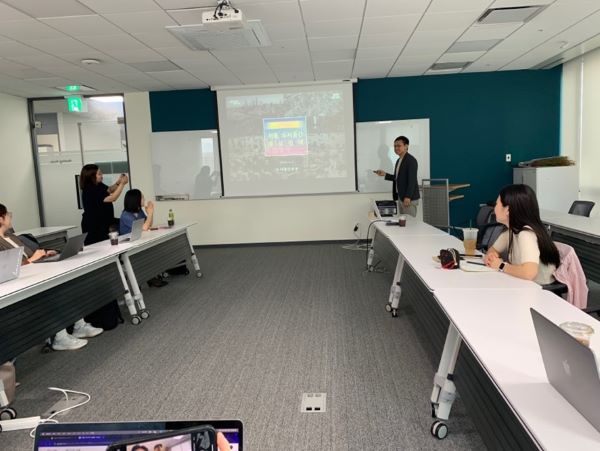
By: Joonyeol Yoon, KGGTF 2024 Youth Intern
Eleven interns from the World Bank KGGTF internship program visited the Seoul Metropolitan Government on April 2, 2024. The tour commences at the Seoul Control Center, where Seoul Transport Operation & Information Service (TOPIS) is located. The first thing the interns witnessed was an overview of the historical development of the Seoul transportation system that was displayed on the wall in the corridor of the control center.

Young Jin Ahn, the officer in TOPIS, provided an account of the historical progression of public transportation and its evolution. Similar to other sectors of public service, the transportation system began to advance following the Korean War. Due to its low national financial status, the city's transportation system was insufficient until the 1970s, when urban infrastructure was constructed. In the 1980s, road coverage and the number of highways were expanded to promote domestic automobile ownership. Since then, the expansion of public transportation has also been exponential. Subway and bus became the predominant modes of transportation in Seoul during the 1990s. Since then, digital infrastructure has advanced, and Seoul now possesses one of the most sophisticated digital transportation systems centered on human needs.

Since its inception in 2004, TOPIS has utilized 6,800 CCTVs deployed throughout Seoul to monitor and record speeding. It is incorporated with the penalty notification and fine system, reducing the time between the detection of violating vehicles and the issuance of fines to less than ten seconds.
Additionally, it gathers road status data, including traffic volumes, speeds, and incidents. The system conducts surveillance on every taxi and bus in Seoul. In addition to CCTVs, information from taxis and public transportation is also incorporated to provide a more complete picture of the road's condition. It controls the entrance approach to the highway and adjusts the interval between traffic signal signs automatically upon receiving the information. This data in real time is linked to the fire and police departments so that they may respond to incidents promptly. By monitoring the status of the bus and publishing the information on the system, the user is able to effectively anticipate the time required to travel from one location to another. In addition to gathering information regarding the payment system, the system also provides the user with data regarding the level of crowding on the buses within the system.
Additionally, Ahn described the environmental approach that TOPIS is putting into practice. A Green Traffic Area was established in Jongro-gu, which prohibits the passage of obsolete vehicles with high smoke emissions; since its designation, the green area has become prominent. Recently, the Cooperative-Intelligent Transport System (C-ITS) was integrated into the system. It is an advanced monitoring system designed to assist automated cars by disseminating real-time road conditions. Currently, in the pilot phase beginning in Sangam Dong, a driver is required to be present on board in order to address unforeseen circumstances, although the system provides information.
Gaining an understanding of how the improved system can contribute to a sustainable government was both insightful and helpful. By implementing the traffic flow regulation system, it becomes apparent that vehicles do not need to maintain their previous emission levels as now they save time in motion. Furthermore, by streamlining the public transportation system, the city could enhance consumer accessibility and persuade them to utilize this mode of transportation. Also, it is encouraging that Seoul has already initiated the installation of state-of-the-art monitoring systems for autonomous vehicles, which will facilitate the transition of internal combustion engine vehicle owners to electric vehicles.
The interns then moved to the Advisory division of urban planning in the 1st Seoul Metropolitan Government (SMG) office building. The team leader of the planning/policy team, Youngjoon Jang, provided an enlightening overview of the policies and plans of the Seoul government regarding the current urban development blueprint. He began with the fundamental conception of the current plan. The department has transitioned its urban planning principles from conceptualization to execution, from segmentation to coverage of a larger area, and from two-dimensional to three-dimensional.
Additionally, Seoul is currently placing a greater emphasis on removing some of the existing restrictive regulations. By implementing more adaptable regulations, the developer is now able to construct buildings to a greater height than before, thereby stimulating the regional economy. The restored Yongsan International Complex plan, which is anticipated to house more multinational corporations in skyscrapers in Seoul, is also an illustration of a more flexible regulation. The Fast Integration Planning initiative has identified 110 areas requiring aerial renovation, with an additional 62 areas in underway. Under this initiative, Seoul establishes guidelines that support rapid development with an integrated administrative process throughout the entire city, district, and community by involving business and public stakeholders.
In addition, the city recently designated the Green Ecological Area in Seoul. It is situated precisely in the urban core, encompassing the vicinity of the Gyeongbok Palace. This region is anticipated to have a greater proportion of green space. The city will construct additional high-rise buildings in this area so that there is more space on the ground for parks. Han River is one of the most recognizable landmarks in Seoul, providing the city's inhabitants with ecological and environmental diversity. Seoul devoted a great deal of attention to Han-river in an endeavor to increase park maintenance and green development.

Following a concise overview of contemporary urban planning, he initiated the discussion. Interns openly expressed their perspectives on the urban planning of Seoul and some of the city's prominent landmarks. The session was especially intriguing due to his presentation of the philosophy and fundamentals underlying urban planning. He emphasized that urban planning must be thoroughly deliberated with other departments, including the Ministry of Land and municipalities encircling the cities. Additionally, he described one of the challenges that governments face in urban planning is that planning is significantly impacted by the leader's philosophy and guiding principles. Therefore, in order to ensure the continuity of such an environment over a prolonged duration, enhanced and rigorous dialogue with the leader is required.
It was a rare opportunity to speak on-site with the individual in command of urban planning in Seoul. It was enlightening to gain an understanding of Seoul's philosophy, which is extremely multidimensional, development-focused, and environmentally conscious. In the end, planning is fundamentally about principles and philosophy. In the same way that it must be practical, it must also have a distinct vision and a long-term perspective.
As the interns arrived at the Seoul City Hall, ongoing interior renovations were taking place. The workers planted the plants on the side of the wall. It was evident that Seoul cared about the environmental aspects of the public sector. Furthermore, upon conducting a site visit to two government offices it became abundantly apparent that each department is exerting considerable effort to implement policies that are more environmentally sustainable. In pursuit of their primary objectives, policies have already incorporated strategies to enhance sustainability, with a specific focus on becoming greener. The interns especially gained valuable insights regarding the integration of environmental approaches into policies across various sectors.
